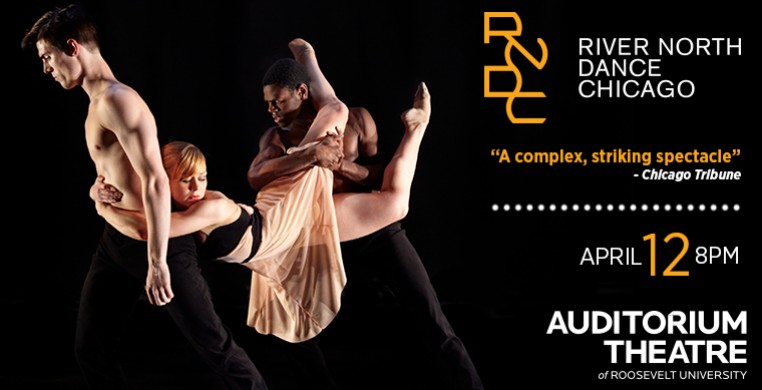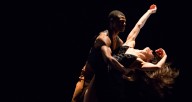A ceremonial tone dominated River North Dance Chicago’s single performance at the Auditorium Theater April 12th, with strong performances that commanded the vast stage and projected all the way to the rafters of an enthusiastic packed house. Distinctive moments stood out in the mix of five works, three by company artistic director Frank Chaves and one each by Kevin Iega Jeff and Mauro Astolfi, but pervasive ritual themes and a preponderance of smoky lighting colored several pieces with a similar feel.
Strikingly different was Chaves’ Stormy Monday, a dramatic duet excerpt from Eva (2013), set to the songs of the late Eva Cassidy, and performed with a rip-your-heart-out rawness by Jessica Wolfrum and Ahmad Simmons. Here was dancing that came from a place where emotions seethe and boil. Dance escaped from the very pores of the dancers because it had to, in a language all their own, not in codified dance steps, but deriving from the complexity of human impulse. Stormy Monday matches Cassidy’s jazzy music and sultry voice with torso-driven gesture, explosive develope turns, split leg lifts, and plenty of fire.
Chaves’ The Good Goodbyes (2012) provided a lyrical, balletic program opener, with the added treat of Chicago Children’s Choir artistic director Josephine Lee performing her original piano score from the orchestra pit. The stated, ceremonial articulation of relationship through highly-stylized group formations in lines and circles, hand-touching, and unison movement gave rise to a sunny, I-love-to-dance flow, distinguished by an over-reliance on arm gestures. Both music and choreography veered toward the sentimental here and there, but when Chaves taps his ability to capture a central truth in human interaction through the use of natural impulse and more core-centered gesture, the work transcends emotional indulgence. The piece gave ample opportunity for the company to show off its considerable technical range and polish, especially in the poignant duet for Hank Hunter and Ethan R. Kirschbaum, two stunning dancers whose virtuosity is complemented by strong dramatic connection to engaging movement material, which Chaves abundantly provides. Here Chaves used contrasting dynamics of strength and capitulation to depict relationship. The men would alternately lean into each other and sink, then pull away and reconnect with interlaced arms across each other’s back, the triumph of exalting lifts and the resignation of collapsed torsos and turned-in knees signaling the fleeting frailty of human contact.
Kevin Iega Jeff’s Dawn (2013) catapulted the stage and dancers into a temple of doom cavern where stiff posturing and ritual worship of a sacrificial priestess told a familiar story of primitive origins. When a choreographer makes such a deliberate choice of style and subject matter, there is an assumption that it all must mean something, that he is telling this particular story to get at a universal truth that speaks to a greater reality, however abstractly. In the case of Dawn, the primitive context gives us a view, if somewhat cliched, into what may have been, but leaves us wondering why.
Contrasting the stated and methodical ritual movement of Dawn, Mauro Astolfi’s Contact Me (2011) offered up the frenzied rites of modern-age coupling with shaking arms, slow writhing, and lots of anger. Overly busy arms seem to be a kind of emotional shorthand that circumvented any deeper anchor in the body. Perpetual motion filled the stage with a mob of people all “talking” too fast at the same time in the chaos and disturbing urgency of their need for human contact. The deliberate agitation of new-age music by Jon Hopkins and Giovanni Sollima and dark, obliterating lighting by Joshua Paul Weckesser washed over repetitive movement with a sameness that diminished the dramatic potential of the work, but the dancers’ hard-earned triumph of execution of this demanding choreography, especially a stand-out performance by Ethan Kirschbaum, salvaged the piece.
Resonant voices of the on-stage chorus of alums from The Chicago Children’s Choir echo across the fog of a far-away time where creatures are evolving out of the organic soup of time in Chaves’Underground Movements (2006). The stated, ceremonial enactments take the dancers on a journey from tribal beginnings to glorious celebration of life, a rousing finale to the evening. Effective integration of the choir into the staging made for an electrifying blend of live music and superb dancing, with luxurious flow, beautiful turns and spot-on balances. Of special note is Lauren Kias’s solo performance in Accepatance. Her freedom and expansive range of movement connected sublimely to Evan Solot’s original music.


